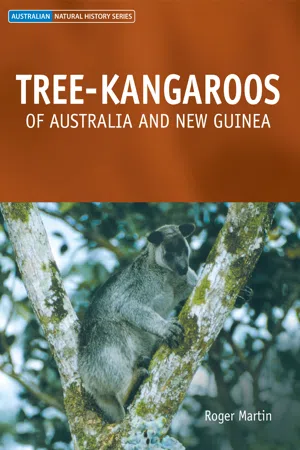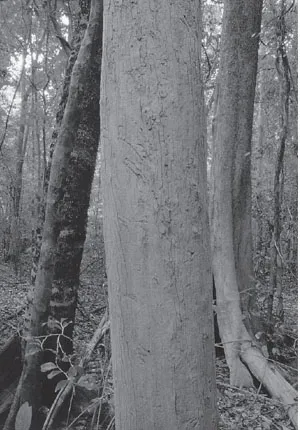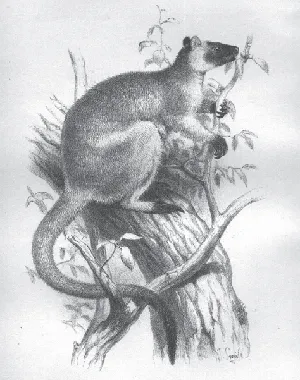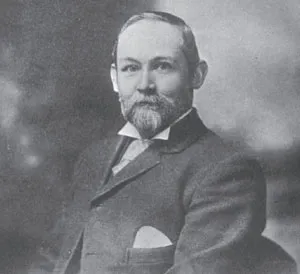![]()
1
A tree-climbing kangaroo?
Some years ago, in a very useful little dictionary of mammal names, Ronald Strahan of the Australian Museum observed that the scientific names of most Australian mammals were derived from either Latin or Greek roots and, assuming one could understand them, these often conveyed useful information about the species. For example, Dendrolagus, the name given to the tree-kangaroo genus, is derived from two Greek words – dendron, meaning tree, and lagos, meaning hare. Strahan mused that while the first part of this name obviously referred to the arboreal lifestyle of the members of the genus, he had no idea why these ‘remarkable short-eared, long tailed animals should be compared to hares’.
To understand why, we need to go back to 1826. In that year the Natural History Commission of the Netherlands Indies began sending scientists to the Dutch East Indies to collect natural history specimens, an initiative largely due to Coenraad Temminck, the son of the Treasurer of the Dutch East India Company. He was a wealthy man with an interest in natural history. The East Indies (now Indonesia) comprises thousands of tropical islands and the first group of Dutch scientists to arrive there used a small sailing vessel, The Triton, to travel around. When they visited Lobo, on the north-west coastline of New Guinea, they collected four individuals of a mammal that was new to science. According to the local people these animals lived in the trees and were relatively common in the forests of the coastal range. They knew them as ‘wangoerie’. The four animals had been raised as pets in local villages and they were taken on board The Triton with the intention of shipping them back to Europe alive. Unfortunately, other circumstances intervened and the wangoerie didn’t make it.
The drawings of the ‘wangoerie’ (Dendrolagus ursinus) and ‘wakera’ (D. inustus) from Schlegel and Muller’s original paper reporting the discovery of these two new species of mammal.
Even today, Europeans who spend time in the coastal areas of New Guinea usually contract ‘fever’ (malaria) or experience some sort of debilitating illness. The scientists on board The Triton were no exception and many were gravely ill by the time the wangoerie came aboard. Three of the animals were immediately killed to provide fresh meat and broth for the sick men. Dr Salomon Muller was one of the few to survive the voyage and he later reported that the meat of the wangoerie was very tasty, far more so than another macropod species ‘fanei’ (Dorcopsis brunii, Forest Wallaby) eaten earlier in the voyage. He noted how proud the ship’s officer was of a special dish that he had prepared for the dying men using this meat, cooking it in the style of ‘hazenpeper’ (peppered hare).
So, it seems that the lagus bit of the scientific name for tree-kangaroo was assigned for gastronomical rather than morphological reasons. The qualities of hare as a game animal have long been appreciated by Europeans and the hungry Dutchmen on board The Triton probably recognised a similar ‘gami-ness’ in tree-kangaroo meat when they first caught its smell wafting from the galley. I made the same association when I first encountered its sweet aroma in hunting camps in the Torricelli Mountains of New Guinea.
The scientific name is really most apt and one that indigenous people from both sides of Torres Strait would applaud as they have long recognised tree-kangaroo as one of the finest game animals in the region. The name also serves to remind modern scientists of the main threat to the survival of tree-kangaroos in the wild. Because their flesh is so tasty tree-kangaroos are still hunted relentlessly in most parts of New Guinea. It is never a wise evolutionary strategy to taste good (witness the plight of the dugong) and although the odds may have favoured tree-kangaroos in the past (when there were fewer hunters and larger areas of habitat available), they don’t anymore.
History of discovery
In addition to the wangoerie, which was given the scientific name Dendrolagus ursinus (referring to the bear-like appearance of what is today known as the Vogelkopt Tree-kangaroo), Salomon Muller and his companions collected a second species of tree-kangaroo in the Lobo district. Known to the locals as ‘wakera’, this was the Grizzled Tree-kangaroo (D. inustus). Only a single specimen, an old female, was obtained and Muller noted that, apart from its longer tail, the animal was broadly similar in overall appearance to the other species. It wasn’t until much later, when describing the skeletal material, that he observed major differences in the long bones (the tibia and fibula) and the ankle bones of the hind limbs of the two species. These, as we will see later, were to prove key characteristics in distinguishing between the two main groups of tree-kangaroos.
The drawings of the hind limbs of the two tree-kangaroo species collected by Salomon Muller and his colleagues in 1826 highlight the different degree of tibio-fibular contact that was to become an important distinguishing characteristic between the two groups of tree-kangaroos. (a) Dendrolagus inustus, (b) D. ursinus.
Half a century was to pass before another tree-kangaroo species was discovered by Europeans. Surprisingly it wasn’t found in New Guinea, but in the rainforests of north Queensland. In 1872 the Queensland Government commissioned William Hann to lead an expedition up Cape York Peninsula to investigate its mineral potential. While passing through rainforest north of the Bloomfield River one of the expedition’s Aboriginal guides, Jerry, came upon a very strange wallaby. Hann recorded in his diary that Jerry first saw this animal when it was on the ground ‘[moving] with the same hopping motion’ as a wallaby. However, when disturbed, it climbed a tree and quickly disappeared into the canopy. Jerry had heard of tree-climbing kangaroos before, from his people living further south, around Cardwell. They knew them as ‘boongary’ and he had often spoken to Hann about them.
William Hann was very sceptical. He wrote in his diary that ‘the idea that any kangaroo known to us could climb a tree would be ridiculous’. However, Jerry had accompanied him on many a long journey and ‘was faithful and obedient in every difficulty and staunch in every danger’ so Hann didn’t lightly dismiss what he had to say. They returned the next day to the tree that Jerry had seen the animal climb and found two deep scratches in its bark. Hann observed that the scratches ‘were totally different from those of an opossum, which leaves marks as if made with a pin’s point’ and that they appeared ‘to have been made with toes of the hind feet’. Further searching revealed similar scratching on many other trees in the area, leading Hann to believe that the animals were probably plentiful in the area. They didn’t see any but did find a complete skeleton which Dr Thomas Tate, another member of the party, enthusiastically collected. But Hann wasn’t on a zoological expedition and he didn’t see the point of carrying such rubbish around with them. During tough going later on in the trip he insisted that Tate discard it, which he did, and there went the first hard evidence of the presence of tree-kangaroos in Australia.
Jerry wasn’t the only one who had heard talk about the unusual tree-climbing kangaroos in the Cardwell area. Rumours had even reached Dr George Bennett at the Australian Museum in Sydney and in 1873 he wrote to the Zoological Society of London suggesting that there may be a tree-kangaroo species, similar to those already described from New Guinea, in the rainforests of north Queensland.
Photo: R. Martin
Scratches left in the bark of a gallery forest tree, Carallia brachiata, by Bennett’s Tree-kangaroo. It was scratches similar to these that lead William Hann to believe that his Aboriginal guide Jerry had indeed seen some type of tree-climbing wallaby in the Bloomfield River district in 1872.
In 1880, perhaps influenced by Bennett’s speculations, the Reverend Carl Lumholtz came to the Cardwell area to search for tree-kangaroos. Lumholtz was sponsored by the University of Christiania (now Oslo) in Norway and eventually collected four new species of mammals from rainforest in the area. These included a tree-kangaroo that he described as ‘the most beautiful mammal’ he had seen in Australia. Robert Collet, his colleague from the University, named the species lumholtzi in his honour.
Lithograph of Lumholtz’s Tree-kangaroo (Dendrolagus lumholtzi) that accompanied the original description of the species in 1884.
As anyone who has tried to capture wild tree-kangaroos will attest, they are exceedingly difficult to find. It took Carl Lumholtz him three months to procure his first specimen and then only after he had enlisted the services of a skilled Aboriginal hunter, Nilgora, and his equally talented dog, Balnglan.
The fourth species of tree-kangaroo, collected in 1883, was found in New Guinea. Its skin came with a shipment of bird skins purchased from a dealer by the Australian Museum. Ornithology was the main passion of the curator, Edward Ramsay. He doesn’t appear to have been very interested in mammals, not even beautiful ones. He only gave a perfunctory description and named the species Dendrolagus dorianus in honour of the Marquis of Doria ‘whose published work on Papuan ornithology he greatly admired’.
Bennett’s Tree-kangaroo
The fifth species to be formally described was the tree-kangaroo first seen by Hann’s party in 1872. A live specimen was obtained in the vicinity of the Daintree River, which is slightly to the south of the Bloomfield River, in 1886 and sent to the Queensland Museum for identification. Unfortunately the animal didn’t travel well. In fact, by the time it reached the Museum, it was long deceased and all that was left was the tattered remains of its skin. With so little material to work with, the museum’s curator, the Reverend Charles De Vis, was understandably tentative in his identification. In his published description he only refers to a ‘probable new species of Dendrolagus’. He didn’t have even any material from D. lumholtzi in the museum for comparison but, from the description published by Robert Collett in 1884, De Vis thought the bits of skin he had before him were from a different species.
He named it Dendrolagus bennettianus in honour of Dr George Bennett who had ‘so often insisted on the probability of Dendrolagus being endemic to Queensland’. (But perhaps he should have called it after Jerry: Jeanette Covacevich, a former Curator at the Queensland Museum, recently pointed out that it was Jerry, after all, who’d observed the first tree-kangaroo to be formally recorded in Australia.) It wasn’t until 1893, when De Vis finally had the opportunity to examine some live tree-kangaroos captured in the Bloomfield River district, that he confirmed D. bennettianus as the second tree-kangaroo species living in the rainforests of north Queensland.
W. H. Dudley Le Souef, from the Zoological and Acclimatisation Society of Victoria, had collected these tree-kangaroos. He was a remarkable man and, given the difficulties usually encountered by those trying to collect tree-kangaroos, he was extraordinarily successful at it. In his first trip to the Bloomfield River he managed to collect six tree-kangaroos in six weeks and to get four of them back to the Melbourne Zoological Gardens alive. On his instructions another 16 were captured later in the following year and also sent to Melbourne Zoo. In 1896 he returned and collected several more, this time from further south around Mount Peter Botte. Captive colonies of tree-kangaroo are rare, even today, and Le Souef’s effort must have been somewhat of a coup for Melbourne’s Zoological Gardens.
Unfortunately the captive colony did not thrive. In a later account on the history of the zoo, Charles Barrett observed ‘our southern climate did not agree with these natives of tropical Queensland’. This is not surprising, given that the animals appear to have been held in an outside enclosure throughout Melbourne’s notoriously cold, wet and windy winters. The fact that Le Souef made several return journeys to north Queensland to collect additional animals suggests that they didn’t breed in captivity and that the colony slowly died out. Some recent research provides an interesting digression on the fate of the final few.
W. H. Dudley Le Souef, a director of Melbourne’s Zoological Gardens, collected several Bennett’s Tree-kangaroos for the zoo in the late 19th century.
The Bennett’s Tree-kangaroo exhibit at the Melbourne Zoological Gardens in the early 20th century.
Originally national parks were seen as refuges for all wildlife – not just the locally occurring species. This was the case for Victoria’s first national park, at Wilsons Promontory, and in its early years more than a dozen non-endemic species were released there, including a few Bennett’s Tree-kangaroos. The two researchers who unearthed this little gem of early conservation practice, Ian Mansergh and the late John Seebeck, didn’t ascertain the source of the animals but I suspect they were from the Melbourne Zoo colony. These authors were charitable in their comment that ‘the beliefs and endeavours of an earlier generation of conservationists must be viewed in the context of their time’ but did go on to observe that the liberation of tropical rainforest mammals onto Wilsons Promontory ‘was optimistic, to say the least’. Perhaps they were released with the fond hope that living free would induce them to breed. Or perhaps it was just a misguided act of compassion, letting a few old animals live out the last of their days in the wild.
The carcasses of the two animals that died in transit from Cape York were put to better use. Tree-kangaroos were s...






